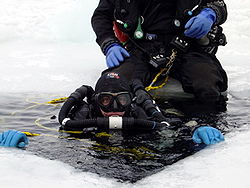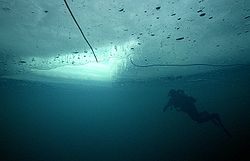
Ice diving
Encyclopedia


Penetration diving
Penetration diving or no clear surface diving is a type of diving where the scuba diver enters a space from which there is no direct, purely vertical ascent to the safety of breathable air of the atmosphere at the surface...
where the dive takes place under ice
Ice
Ice is water frozen into the solid state. Usually ice is the phase known as ice Ih, which is the most abundant of the varying solid phases on the Earth's surface. It can appear transparent or opaque bluish-white color, depending on the presence of impurities or air inclusions...
. Because diving under ice places the diver in an overhead environment typically with only a single entry/exit point, it is considered an advanced type of diving requiring special training (although whether it constitutes technical diving
Technical diving
Technical diving is a form of scuba diving that exceeds the scope of recreational diving...
is part of a wider debate within the diving community). Ice diving should not be attempted by anyone not trained (or in training) by a qualified instructor.
This special training includes learning about how ice forms, how to recognize unsafe ice conditions, dive site preparation, equipment requirements, and safety drills. Ice divers are tethered for safety. What this means is that the diver is wearing a special harness under his/her scuba unit. A line is secured to this harness, and the other end of the line is secured to the surface by one of a number of methods.
Ice diving is a team diving activity because the divers line requires a line tender. This person is responsible for playing out and taking in line so that the diver does not get tangled. Communication to the diver, or to the surface, is accomplished by pulling on the line. Each series of tugs means a different thing. There is a diver suited up and ready to enter the water at a moment's notice. This diver is a safety diver, and has his own tender. His purpose is to assist the primary diver in the event of a problem.
Training
- How to impact the underside of the surface ice if the diver's weight belt falls off for any reason and the diver ascends uncontrollably and rapidly.
- How to deal with a frozen air-supply system using a redundant back-up system.
- What to do in the event the diver loses contact with the line or the line tender does not get feedback from the diver in response to signals given to the diver.
Equipment
Since diving under the ice takes place in cold climates, there is typically a large amount of equipment required. Besides each person's clothing and exposure-protection requirements, including spare mitts and socks, there is basic scuba gear, back-up scuba gear, tools to cut a hole in the ice, snow removal tools, safety gear, some type of shelter, lines, and refreshments required.Procedures and precautions
- Use a snow shovel to clear the snow and ice from the area.
- Use an ice saw or a chain saw to cut a hole in the ice.
- Use a weatherproof area for the divers to suit up.
- Use a diving regulatorDiving regulatorA diving regulator is a pressure regulator used in scuba or surface supplied diving equipment that reduces pressurized breathing gas to ambient pressure and delivers it to the diver. The gas may be air or one of a variety of specially blended breathing gases...
suitable for cold-water use. All regulators have a risk of freezing and free flowing—in this case, the diver should immediately return to the surface. Some models fare better than others. Good practice—two unfreezing regulators arranged as follows: first stage number 1 with primary second stage, BCD inflation hose and Submersible Pressure Gauges, first stage number 2 with secondary second stage (octopus), dry suit inflation hose and Submersible Pressure Gauges. - Connect the diver and tender on the surface with a ropeRopeA rope is a length of fibres, twisted or braided together to improve strength for pulling and connecting. It has tensile strength but is too flexible to provide compressive strength...
and harness. The harness is typically put on over the dry suit but under the BC or other buoyancy device so that the diver remains tethered even if he or she must remove his or her air cylinder or buoyancy control device. The harness fits over the shoulders and around the back such that the tender on the surface can, in an emergency, haul an unconscious diver back to the hole. - Use rope signalsDiving signalDiver communications are the methods used by divers to communicate with each other or with surface members of the dive team.There are several distinct forms of diver communications:...
. - Have a standby rescue, roped diver ready on the surface.
- Have one or two divers diving at the same time from the same hole, each with his or her own rope. Using two ropes runs little risk of getting tangled together, but using three significantly increases this risk.
Exposure suits
Because of the water temperature (about 4°C in fresh water), exposure suits are mandatory.Some consider a dry suit
Diving suit
A diving suit is a garment or device designed to protect a diver from the underwater environment. A diving suit typically also incorporates an air-supply .-History:...
mandatory; however, a thick wetsuit is also sufficient for hardier divers. A wetsuit can be pre-heated by pouring warm water into the suit. A hood and gloves (recommended three-finger mitts or dry gloves with rings) are mandatory, and dry-suit divers have the option of using hoods and gloves that keep their head and hands dry. Some prefer a to use a full face diving mask
Full face diving mask
A full-face diving mask is a type of diving mask that seals the whole of the diver's face from the water and contains a mouthpiece or demand valve that provides the diver with breathing gas...
to essentially eliminate any contact with the cold water.
The biggest drawback to using a wet suit is the chilling effect the water evaporating off the suit has on the diver. This can be reduced by using a heated shelter.
Outfit Recommendations:
- Warm waterproof shoes.
- Warm anorak for cold weather.
- Warm cap covering the ears.
- Sunglasses with a UV filter to protect the eyes in sunny days.
- Lip-care stick and cream to protect hands and face against cold and wind.

